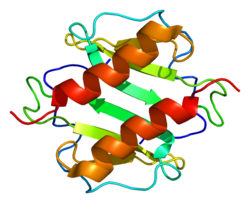CXCL1
Phối tử chemokine (mô-típ CXC) 1(CXCL1) là mộtcytokinenhỏ thuộc họchemokineCXC trước đây được gọi là GRO1 oncogene, GROα, KC, protein kích hoạt tăng bạch cầu trung tính 3 (NAP-3) MGSA-α). Ở người, protein này được mã hóa bởi CXCL1.[3]
Chức năng
[sửa|sửa mã nguồn]CXCL1 được tiết ra bởi các tế bàou ác tínhở người, có đặc tính giảm thiểu và có liên quan đếnsinh bệnhu ác tính.[4][5]CXCL1 được thể hiện bởicác đại thực bào,bạch cầu trung tínhvàtế bào biểu mô,[6][7]và có hoạt tính hóa học bạch cầu trung tính.[8][9]CXCL1 đóng một vai trò trong sự phát triển tủy sống bằng cách ức chế sự di chuyển của tiền chất oligodendrocyte và tham gia vào các quá trìnhtạo mạch,sinhđộng mạch,viêm,chữa lành vết thươngvàsinh khối u.[10][11][12][13]Chemokinenày gợi ra tác dụng của nó bằng cách truyền tín hiệu qua thụ thể chemokineCXCR2.Gencho CXCL1 nằm trênnhiễm sắc thể 4ở người trong số các gen của các chemokine CXC khác.[14]Một nghiên cứu ban đầu trên chuột cho thấy bằng chứng cho thấy CXCL1 đã giảm mức độ nghiêm trọng củabệnh đa xơ cứngvà có thể có chức năng bảo vệ thần kinh.[15]
Tham khảo
[sửa|sửa mã nguồn]- ^abcGRCh38: Ensembl release 89: ENSG00000163739-Ensembl,May 2017
- ^“Human PubMed Reference:”.
- ^Haskill S, Peace A, Morris J, Sporn SA, Anisowicz A, Lee SW, Smith T, Martin G, Ralph P, Sager R (tháng 10 năm 1990).“Identification of three related human GRO genes encoding cytokine functions”.Proc. Natl. Acad. Sci. U.S.A.87(19): 7732–6.Bibcode:1990PNAS...87.7732H.doi:10.1073/pnas.87.19.7732.PMC54822.PMID2217207.
- ^Anisowicz A, Bardwell L, Sager R (tháng 10 năm 1987).“Constitutive overexpression of a growth-regulated gene in transformed Chinese hamster and human cells”.Proc. Natl. Acad. Sci. U.S.A.84(20): 7188–92.Bibcode:1987PNAS...84.7188A.doi:10.1073/pnas.84.20.7188.PMC299255.PMID2890161.
- ^Richmond A, Thomas HG (tháng 2 năm 1988). “Melanoma growth stimulatory activity: isolation from human melanoma tumors and characterization of tissue distribution”.J. Cell. Biochem.36(2): 185–98.doi:10.1002/jcb.240360209.PMID3356754.
- ^Iida N, Grotendorst GR (tháng 10 năm 1990).“Cloning and sequencing of a new gro transcript from activated human monocytes: expression in leukocytes and wound tissue”.Mol. Cell. Biol.10(10): 5596–9.doi:10.1128/mcb.10.10.5596.PMC361282.PMID2078213.
- ^Becker S, Quay J, Koren HS, Haskill JS (tháng 3 năm 1994). “Constitutive and stimulated MCP-1, GRO alpha, beta, and gamma expression in human airway epithelium and bronchoalveolar macrophages”.Am. J. Physiol.266(3 Pt 1): L278–86.doi:10.1152/ajplung.1994.266.3.L278.PMID8166297.
- ^Moser B, Clark-Lewis I, Zwahlen R, Baggiolini M (tháng 5 năm 1990).“Neutrophil-activating properties of the melanoma growth-stimulatory activity”.J. Exp. Med.171(5): 1797–802.doi:10.1084/jem.171.5.1797.PMC2187876.PMID2185333.
- ^Schumacher C, Clark-Lewis I, Baggiolini M, Moser B (tháng 11 năm 1992).“High- and low-affinity binding of GRO alpha and neutrophil-activating peptide 2 to interleukin 8 receptors on human neutrophils”.Proc. Natl. Acad. Sci. U.S.A.89(21): 10542–6.doi:10.1073/pnas.89.21.10542.PMC50375.PMID1438244.
- ^Tsai HH, Frost E, To V, Robinson S, Ffrench-Constant C, Geertman R, Ransohoff RM, Miller RH (tháng 8 năm 2002). “The chemokine receptor CXCR2 controls positioning of oligodendrocyte precursors in developing spinal cord by arresting their migration”.Cell.110(3): 373–83.doi:10.1016/S0092-8674(02)00838-3.PMID12176324.
- ^Vries MH, Wagenaar A, Verbruggen SE, Molin DG, Dijkgraaf I, Hackeng TH, Post MJ (tháng 4 năm 2015). “CXCL1 promotes arteriogenesis through enhanced monocyte recruitment into the peri-collateral space”.Angiogenesis.18(2): 163–71.doi:10.1007/s10456-014-9454-1.PMID25490937.
- ^Devalaraja RM, Nanney LB, Du J, Qian Q, Yu Y, Devalaraja MN, Richmond A (tháng 8 năm 2000).“Delayed wound healing in CXCR2 knockout mice”.J. Invest. Dermatol.115(2): 234–44.doi:10.1046/j.1523-1747.2000.00034.x.PMC2664868.PMID10951241.
- ^Owen JD, Strieter R, Burdick M, Haghnegahdar H, Nanney L, Shattuck-Brandt R, Richmond A (tháng 9 năm 1997). “Enhanced tumor-forming capacity for immortalized melanocytes expressing melanoma growth stimulatory activity/growth-regulated cytokine beta and gamma proteins”.Int. J. Cancer.73(1): 94–103.doi:10.1002/(SICI)1097-0215(19970926)73:1<94::AID-IJC15>3.0.CO;2-5.PMID9334815.
- ^Richmond A, Balentien E, Thomas HG, Flaggs G, Barton DE, Spiess J, Bordoni R, Francke U, Derynck R (tháng 7 năm 1988).“Molecular characterization and chromosomal mapping of melanoma growth stimulatory activity, a growth factor structurally related to beta-thromboglobulin”.EMBO J.7(7): 2025–33.doi:10.1002/j.1460-2075.1988.tb03042.x.PMC454478.PMID2970963.
- ^Omari KM, Lutz SE, Santambrogio L,Lira SA,Raine CS (tháng 1 năm 2009).“Neuroprotection and remyelination after autoimmune demyelination in mice that inducibly overexpress CXCL1”.Am. J. Pathol.174(1): 164–76.doi:10.2353/ajpath.2009.080350.PMC2631329.PMID19095949.
Liên kết ngoài
[sửa|sửa mã nguồn]- Vị trí bộ genCXCL1ở người và thông tin chi tiết về genCXCL1có sẵn trênUCSC Genome Browser.



